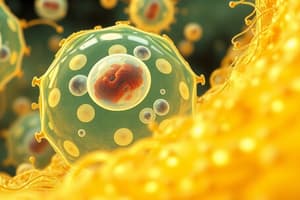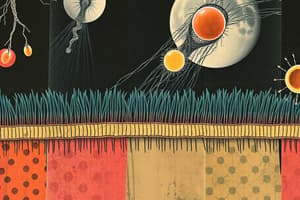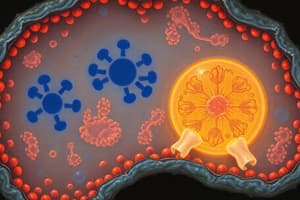Podcast
Questions and Answers
What is the basic unit of all living organisms?
What is the basic unit of all living organisms?
- Electrons
- Cells (correct)
- Atoms
- Neutrons
What defines the type of element based on the text?
What defines the type of element based on the text?
- Number of electrons
- Number of protons (correct)
- Atomic weight
- Number of neutrons
What type of bond is formed when electrons are shared equally between two atoms?
What type of bond is formed when electrons are shared equally between two atoms?
- Nonpolar covalent bond (correct)
- Single bond
- Polar covalent bond
- Ionic bond
What is the charge of an ion that has gained two electrons?
What is the charge of an ion that has gained two electrons?
What is the function of peroxisomes mentioned in the text?
What is the function of peroxisomes mentioned in the text?
What is the structure that stabilizes, supports, and transports within the cell?
What is the structure that stabilizes, supports, and transports within the cell?
What is the primary dysfunction related to microtubules mentioned in the text?
What is the primary dysfunction related to microtubules mentioned in the text?
What is found near the nucleus and made of two parts, including centrioles and pericentriolar matrix?
What is found near the nucleus and made of two parts, including centrioles and pericentriolar matrix?
What separates the nucleus from the cytoplasmic compartment?
What separates the nucleus from the cytoplasmic compartment?
What is responsible for producing RNA for ribosomes and is located inside the nucleus?
What is responsible for producing RNA for ribosomes and is located inside the nucleus?
How do cells communicate with other cells in the body to maintain homeostasis?
How do cells communicate with other cells in the body to maintain homeostasis?
What type of communication involves the release of hormone into the bloodstream and binding to a specific target cell receptor?
What type of communication involves the release of hormone into the bloodstream and binding to a specific target cell receptor?
What are the four key functions of the plasma membrane?
What are the four key functions of the plasma membrane?
What is the main function of the mitochondria?
What is the main function of the mitochondria?
What is the primary role of the rough endoplasmic reticulum?
What is the primary role of the rough endoplasmic reticulum?
What are the main components of the cytoplasm?
What are the main components of the cytoplasm?
What is the function of secretory vesicles?
What is the function of secretory vesicles?
What is the role of lysosomes in the cell?
What is the role of lysosomes in the cell?
What is the function of the Golgi apparatus?
What is the function of the Golgi apparatus?
What are the primary components of the plasma membrane?
What are the primary components of the plasma membrane?
What is the composition of the human body in terms of the six compounds?
What is the composition of the human body in terms of the six compounds?
What is the main function of peroxisomes in the cell?
What is the main function of peroxisomes in the cell?
What is the role of membrane-spanning proteins in the plasma membrane?
What is the role of membrane-spanning proteins in the plasma membrane?
What is the primary role of ribosomes in the cell?
What is the primary role of ribosomes in the cell?
Flashcards are hidden until you start studying
Study Notes
Cell Structure and Function Overview
- Human body is 97% composed of 6 compounds: carbon, oxygen, nitrogen, hydrogen, sulfur, and phosphorus
- The body is organized with basic building blocks, followed by cells working together with tissues and organs for homeostasis
- The plasma membrane has four key functions: physical isolation, exchange of substances, intercellular communication, and structural support
- The plasma membrane is a double layer of lipids with dispersed proteins, containing polar hydrophilic and nonpolar hydrophobic regions
- Membrane-spanning proteins in the bilayer have various functions such as transport, signaling, and structural support
- The cytoplasm consists of cytosol and organelles, including membranous structures like the mitochondria, endoplasmic reticulum (ER), and Golgi apparatus
- The mitochondria, known as the powerhouse of the cell, produce ATP and have their own DNA and RNA
- The endoplasmic reticulum can be smooth (for lipid synthesis and calcium ion storage) or rough (site of protein synthesis)
- Ribosomes, responsible for making proteins, can be free or attached to the endoplasmic reticulum
- The Golgi apparatus modifies, concentrates, sorts, and packages proteins or lipids received from the ER for secretion or transport
- Secretory vesicles are packages of cell secretions transported within or outside cells and contain proteins, hormones, or neurotransmitters
- Lysosomes contain enzymes for cleaning up worn-out organelles, killing bacteria, and are protective for the cell, while peroxisomes detoxify or neutralize free radicals and proteasomes degrade unneeded or damaged proteins
Studying That Suits You
Use AI to generate personalized quizzes and flashcards to suit your learning preferences.




